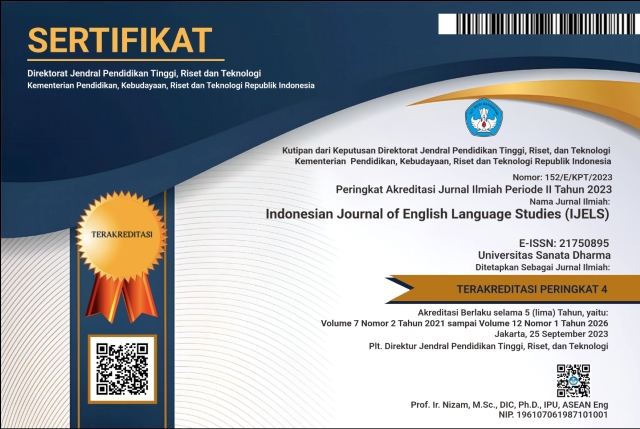English Compound Words Used in The Jakarta Post’s Health Column on Third Week of June 2020
(1) Universitas Sanata Dharma, Indonesia
(*) Corresponding Author
Abstract
This study aims to describe the orthographic features, word formation and the meaning of compound words related to COVID-19 pandemics used in The Jakarta Post’s Health Column Article on Third Week of June 2020. There are three research questions in this study: (1) What are orthographic features found in the compound words, (2) What are the type of compound words and their lexical categories, and (3) How do the compound words create meaning. To answer the research question, the writer use the theory of morphology and semantics. The findings showed there are 34 compound words in The Jakarta Post’s Health Column on the third week of June 2020. The compound words found in this study are written mostly in one word. Then, the rest of compound words are written with a hyphen, and separately in two or three words. Based on the type of compound words, there are 82.35% compound noun, 11.75% compound adjective, and 5.9% compound verb. The most dominant lexical category is from compound nouns which are Noun + Noun and Adjective + Noun. Based on the meaning of compound words, there are 85.3% endocentric compounds and 14.7% exocentric compounds.
Full Text:
PDFReferences
Akmajian, A., Demers, R. A., Farmer, A. K., & Harnish, R. M. (2010). Linguistics: An Introduction to Language and Communication (6th ed.). Massachusetts Institute of Technology Press.
Al-Salman, S., & Haider, A. S. (2021). Covid-19 Trending Neologisms and Word Formation Processes in English. Russian Journal of Linguistics, 25(1), 24–42. https://doi.org/10.22363/2687-0088-2021-25-1-24-42
Aronoff, M., & Fudeman, K. (2011). What is Morphology? Wiley-Blackwell.
Booij, G. (2005). The Grammar of Words. Oxford University Press.
Butar, B. P. B. (2021). The Word Formation and Semantic Domains in Covid-19 Sections in WHO Website.
Downing, P. (1977). On the creation and use of English compound nouns. Language, 53(4), 810-842. https://doi.org/10.2307/412913
Fabb, N. (2007). Compounding. In The Handbook of Morphology (pp. 1–13). Wiley-Blackwell.
Finegan, E. (2008). Language: Its Structure and Use (5th ed.). Tomson Wadsworth.
Fromkin, V. (2014). An Introduction to Language (10th ed.). Wadsworth Cengage Learning.
Hammersley, M. (2013). What is Qualitative Research? Bloomsbury Academic.
Haspelmath, M., & Sims, A. D. (2010). Understanding Morphology (2nd ed.). Hodder Educatioin.
Heigham, J., & Croker, R. (2009). Qualitative Research in Applied Linguistics: A Practical Introduction. Palgrave Macmillan UK.
Kusumaningsih, D., Hanafi, H., Ningrum, W. E., Wardhana, D. E. C., & Wibawa, S. A. (2020). The Impacts of COVID-19 on Indonesian Language Terminology. 477(Iccd), 175–181. https://doi.org/10.2991/assehr.k.201017.040
Libben, G. (2006). Why Study Compound Processing? An overview of the issues. In The Representation and Processing of Compound Words (p. 28).
Lieber, R. (2009). Introducing Morphology. Cambridge University Press. https://doi.org/10.1017/cbo9781316156254
Matthews, P. H. (2006). Morphology. In Advanced Information and Knowledge Processing (2nd ed.). Cambridge University Press. https://doi.org/10.1007/978-1-84628-986-6_4
McCharty, M., & O’Dell, F. (2001). English Vocabulary in Upper Intermediate in Use with Answers. Cambridge University Press. https://www.google.co.id/books/edition/English_Vocabulary_in_Use_Upper_Intermed/Am7j358w-4UC?hl=en&gbpv=1
O’Grady, W., & John, A. (2016). Contemporary Linguistic Analysis: An Introduction (8th ed.). Pearson Education, Inc.
Plag, I. (2002). Word-formation in English. Word-Formation in English, 1–240. https://doi.org/10.1017/CBO9780511841323
Simatupang, E. C., & Supri, I. Z. (2020). Compound Words That Occur During the Global Pandemic Covid-19: a Morphosemantic Study. English Review: Journal of English Education, 8(2), 291. https://doi.org/10.25134/erjee.v8i2.2824
Zed, M. (2004). Metode Penelitian Kepustakaan. Yayasan Pustaka Obor Indonesia.
DOI: https://doi.org/10.24071/ijels.v8i1.3231
Refbacks
- There are currently no refbacks.

This work is licensed under a Creative Commons Attribution-ShareAlike 4.0 International License.
IJELS Journal Sinta 4 Certificate (S4 = Level 4)
We would like to inform you that Indonesian Journal of English Language Studies (IJELS) has been nationally accredited Sinta 4 by the Ministry of Education, Culture, Research and Technology of the Republic of Indonesia based on the decree No. Surat Keputusan 152/E/KPT/2023. Validity for 5 years: Vol 7 No 2, 2021 till Vol 12 No 1, 2026

This work is licensed under CC BY-SA.
Creative Commons Attribution-ShareAlike 4.0 International License
IJELS e-ISSN 2715-0895; IJELS p-ISSN 2442-790X
Indonesian Journal of English Language Studies (IJELS) is published twice a year, namely in March and September, by the English Language Studies (ELS) of the Graduate Program of Sanata Dharma University, Yogyakarta, Indonesia.


 IJELS p-ISSN:
IJELS p-ISSN: 









